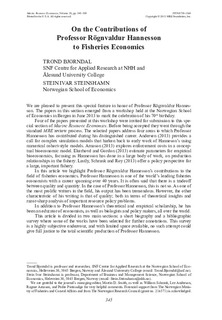On the Contributions of Professor Rögnvaldur Hannesson to Fisheries Economics
Journal article, Peer reviewed
Published version
Permanent lenke
http://hdl.handle.net/11250/2486547Utgivelsesdato
2013Metadata
Vis full innførselSamlinger
Sammendrag
We are pleased to present this special feature in honor of Professor Rögnvaldur Hannesson. The papers in this section emerged from a workshop held at the Norwegian School of Economics in Bergen in June 2013 to mark the celebration of his 70th birthday. Four of the papers presented at this workshop were invited for submission to this special section of Marine Resource Economics. Before being accepted they went through the standard MRE review process. The selected papers address four areas to which Professor Hannesson has contributed to during his distinguished career. Andersen (2013) provides a call for complex simulation models that harken back to early work of Hanneson’s using numerical cohort-style models. Arnason (2013) explores enforcement costs in a conceptual bioeconomic model. Ekerhovd and Gordon (2013) estimate parameters for empirical bioeconomics, focusing as Hannesson has done in a large body of work, on production relationships in the fishery. Lastly, Schrank and Roy (2013) offer a policy perspective for a large, important fishery. In this article we highlight Professor Rögnvaldur Hannesson’s contributions to the field of fisheries economics. Professor Hannesson is one of the world’s leading fisheries economists with a career spanning over 40 years. It is often said that there is a tradeoff between quality and quantity. In the case of Professor Hannesson, this is not so. As one of the most prolific writers in the field, his output has been tremendous. However, the other characteristic of his writing is that of quality; both in terms of theoretical insights and razor-sharp analysis of important resource policy problems. In addition to Professor Hannesson’s theoretical and empirical scholarship, he has been an educator of economists, as well as biologists and policy makers, all over the world. This article is divided in two main sections: a short biography and a bibliographic survey where some of the works have been selected for further annotations. This survey is a highly subjective endeavour, and with limited space available, no such attempt could give full justice to the total scientific production of Professor Hannesson.
